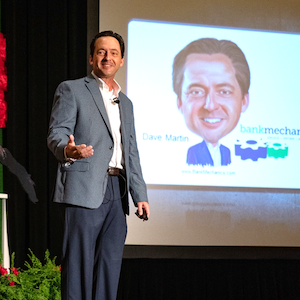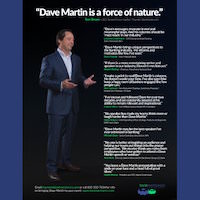 |
 |
"You know how to tell when somebody needs encouragement? If they're breathing." » Truett Cathy
Opportunities Sprouting Up
A serving of charbroiled Brussels sprouts got me reflecting recently on some of the marketing and sales advice I preach to bankers.
Okay, I’ll admit that’s an odd premise. But stay with me.
As I began eating one of my favorite dishes, I thought about the first time I had it. It was not in my childhood.
Far from it, in fact. It was only about 10 years ago.
Growing up in Cajun country, our vegetable preferences tended to be whatever was thrown into the pot at a crawfish or crab boil. Let’s just say that sprouts never made the cut.
So, in my first 4 ½ decades on this planet, if you would have asked me if I’d like Brussels sprouts, the answer would have been a hard “No.”
The world is full of great food. Why would I want to eat dense balls of leaves… or whatever they are.
Then, on a business trip with an old friend and coworker, he ordered grilled Brussels sprouts as an appetizer for us to share.
I looked at him and said, “Dude…seriously? Did your mom say you had to eat that stuff, or you couldn’t have dessert?”
He laughed and said, “I don’t know where you’ve had them, but you’ll like them here.”
I didn’t have the nerve to tell him, “Well… ha! You’re wrong! I’ve never actually tried them because they’re yucky!”
Then I did. And they quickly became my go to dish whenever they were on the menu anywhere.
Based on decades of evidence, no one would ever think that Brussel sprouts would be something I’d even try, much less become one of my favorite foods.
Okay, I doubt that conundrum ever crossed anyone’s mind. But stay with me.
There is no doubt that patterns and behaviors and preferences can be predictive of future conduct.
But…sometimes, all that is needed for a change is being made aware of another option. Just because someone is not actively looking for options doesn’t mean they will not consider and try them if asked.
It's human nature to assume that if a bank (or branch) has existed for some time, it’s been fully evaluated by potential customers.
A person who has never spoken to you and has long term banking relationships elsewhere is simply never going to suddenly consider you. Right?
Well…wrong. Many of your future best customers bank elsewhere now.
Keep telling your story.
You never know just when and where your next opportunity will sprout.
Still in the Loop
It’s been several years since I talked extensively in presentations about the open loop nature of the brain’s limbic system.
Yet, I frequently find myself wanting to pull various business managers off to the side for a short course.
Without necessarily being conscious of it, we continually gauge demeanors and assess the attitudes and predispositions of people we interact with.
Things as simple as body language, eye contact, facial expressions, and verbal tones often communicate as much to us as the actual words spoken.
I once joked about a coworker who could make you mad wishing you a “Good morning.”
I know that sounds impossible. Trust me on that one.
Well, I recently purchased the wrong size of replacement cushions for our patio furniture.
To be honest, the thought of having to return them had me asking if we could simply get used to giant gaps in the cushions.
My wife was not keen on the idea.
When I later queued up in the return line, it was long enough that I couldn’t hear the discussion at the counter.
But it eventually evolved into a “call the manager” situation.
Before that manager spoke a word, I could sense things weren’t going to go well.
I can’t attest for the kind of day she was having. But she sure wasn’t looking to improve anyone else’s.
The kicker for me was that she spoke directly to the employee…about the customer’s issue… without ever looking at the customer standing 4 feet away.
It was hard to tell if that manager was mad at the customer, the employee, or the world.
In the end, it appeared the customer got what she wanted… and still left fuming.
There was no doubt that the others in line who witnessed that manager’s comportment then walked up with their defenses up, ready to argue.
Now, there is no doubt that some folks are harder to diffuse than others.
But most often, customers with problems are more anxious and confused than angry.
When we display empathy and respect in word, gesture, and tone, most issues can be resolved amicably.
This is usually true regardless of what the ultimate solution turns out to be.
Each of us greatly shapes the environments we (and our teams) work in every day with the attitude we choose to display to others.
What environment are you creating today?









